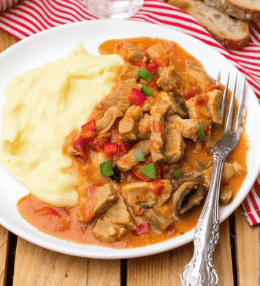
- View
Table of Contents
ToggleČobanac, a hearty hunter’s meat stew from eastern Croatia where farming traditions and open plains shape daily life. Cooked slowly in large cauldrons over open flames, it offers both warmth and depth.
The dish is rustic yet generous, often made in big batches for gatherings and celebrations. Its bold red colour, drawn from paprika, signals the strength of flavour inside. Meat, spice, and long simmering combine to create something rich and memorable.
For locals, Čobanac is not just a hearty stew but a dish that speaks of fellowship. It is cooked outdoors, shared with neighbours and friends, and linked closely with moments of celebration. In this way, food becomes community.
Want to dive deeper into Croatian Cuisine? Don’t miss our post on Traditional Croatian Foods to Try
What Is Čobanac?
Čobanac is a traditional meat stew prepared with a mix of different meats, usually beef, pork, and game. Cooked in a large iron pot, it is simmered for hours until the meat is tender and the sauce is thick, spiced, and full of depth.
The stew is defined by its use of paprika, both sweet and hot, which gives it its deep red colour and characteristic flavour. Garlic, onions, and wine round out the broth, creating a sauce that clings to every piece of meat.
It is commonly served with homemade bread or noodles, allowing the rich sauce to be soaked up fully. The portion is always generous, as Čobanac is meant to be enjoyed in company rather than alone at a quiet table.
Ingredients and Taste
The foundation of Čobanac is meat, and the variety matters. Beef adds depth, pork brings fat and richness, while venison or other game lends intensity. This mix gives the stew layers of flavour that evolve as it cooks.
Onions, garlic, paprika, and bay leaves form the base of the sauce. Red wine adds body and acidity, while hot paprika provides heat that can range from gentle warmth to fiery strength, depending on the cook’s preference.
The taste is bold, savoury, and smoky with a slow building spice that lingers. The meat is tender from long simmering, while the sauce is thick and aromatic. It is both warming and filling, perfect for cold evenings or festive outdoor feasts.
A Taste of History
Čobanac has its roots in Slavonia, a region known for fertile land and long traditions of farming and hunting. It was born from the practical need to feed groups of hunters or farm workers using whatever meat was available.
Cooking it in large cauldrons outdoors gave the dish its communal character. The pot simmered for hours while stories were told, drinks shared, and work or hunting came to an end. It was food shaped by labour and fellowship.
Over time, it grew into a dish strongly tied to identity. Festivals in Slavonia often feature competitions to see who can make the finest Čobanac, with each cook guarding their method of balancing meats, spices, and heat.
Today, Čobanac stands as a symbol of Slavonian hospitality. Whether prepared at a village gathering or served in a restaurant, it continues to bring people together through flavour, history, and a reminder of life shaped by the land.
How to Make Čobanac (Hunter’s Meat Stew)
Čobanac is a rustic Croatian stew from Slavonia, once cooked outdoors in large cauldrons by shepherds and hunters. It is bold, deeply spiced with paprika, and brimming with tender cuts of meat. Expect a hearty, warming dish with a rich red broth that gains flavour as it slowly simmers. See the recipe card at the bottom for printable directions
Ingredients
For the stew
- 400g beef (chuck or shank), cut into cubes
- 400g pork (shoulder), cut into cubes
- 300g venison (or lamb if unavailable), cut into cubes
- 2 large onions, finely chopped
- 4 garlic cloves, minced
- 2 tbsp pork lard (or sunflower oil)
- 2 tbsp sweet Hungarian paprika
- 1 tsp hot paprika (adjust to taste)
- 2 bay leaves
- 1 tsp caraway seeds, lightly crushed
- 2 medium carrots, sliced
- 2 medium potatoes, diced
- 2 fresh tomatoes, peeled and chopped (or 200g tinned tomatoes)
- 1 fresh chilli (optional), finely sliced
- 150ml dry red wine
- 1.2 litres beef stock
- Salt and freshly ground black pepper, to taste
For serving
- Crusty bread or homemade noodles
Cooking Instructions
Step 1: Render the base fat
To begin, place a large heavy pot over medium heat. Melt pork lard until shimmering. This base fat carries flavour and adds depth to the stew. Transition to adding onions.
Step 2: Sweat the onions
Add finely chopped onions and cook slowly until golden brown, stirring often. The onions should caramelise gently without burning, forming the flavour foundation. Move to garlic and spices.
Step 3: Build the spice base
Stir in minced garlic, sweet paprika, hot paprika, caraway seeds, and bay leaves. Toast briefly to release aromas, but avoid scorching paprika. Continue by adding the meat.
Step 4: Brown the meat
Add beef, pork, and venison cubes. Sear until the surfaces are well browned. Work in batches if necessary to avoid steaming. Transition to adding vegetables.
Step 5: Add vegetables
Mix in carrots, potatoes, tomatoes, and optional fresh chilli. Stir to coat in the spiced fat and meat juices. Next, pour in the liquid components.
Step 6: Deglaze with wine
Pour in dry red wine, scraping the bottom to lift any caramelised bits. Allow alcohol to cook off for 2–3 minutes. Move to adding stock.
Step 7: Add stock and simmer
Pour in beef stock until meat and vegetables are submerged. Bring to a boil, then reduce to a gentle simmer. Cover partially and cook slowly for 2–3 hours. Stir occasionally.
Step 8: Adjust seasoning
As the stew thickens, taste and adjust with salt, black pepper, or extra paprika. Continue cooking until meat is fork tender and the broth rich in colour.
Step 9: Rest the stew
Once cooked, remove from heat and let the stew rest for 10–15 minutes. Resting allows flavours to meld and broth to settle. Prepare serving bowls in the meantime.
Final Step: Serve hot
Ladle into deep bowls and serve with crusty bread or homemade noodles. Garnish with a sprinkle of fresh parsley if desired. Presentation tip: serve in clay bowls for traditional flair.
Variations and substitutions
- Replace venison with lamb or more beef if unavailable.
- Use vegetable oil instead of pork lard for a lighter option.
- Swap Hungarian paprika with Spanish paprika if necessary, though Hungarian provides the authentic character.
- Add bell peppers or mushrooms for regional variations.
Cooking Tips for Perfect Čobanac
- Use a mix of meats for depth of flavour rather than relying on one type.
- Do not rush the onion caramelisation, as it sets the tone of the stew.
- Always bloom paprika in fat briefly to draw out its full aroma.
- A slow simmer ensures meat tenderises without falling apart.
- Prepare a day ahead if possible, as flavours deepen overnight.

Croatian Čobanac (Hunter’s Meat Stew)
Ingredients
For the stew
- 400 g beef chuck or shank, cut into cubes
- 400 g pork shoulder, cut into cubes
- 300 g venison or lamb if unavailable, cut into cubes
- 2 large onions finely chopped
- 4 garlic cloves minced
- 2 tbsp pork lard or sunflower oil
- 2 tbsp sweet Hungarian paprika
- 1 tsp hot paprika adjust to taste
- 2 bay leaves
- 1 tsp caraway seeds lightly crushed
- 2 medium carrots sliced
- 2 medium potatoes diced
- 2 fresh tomatoes peeled and chopped (or 200g tinned tomatoes)
- 1 fresh chilli optional, finely sliced
- 150 ml dry red wine
- 1.2 litres beef stock
- Salt and freshly ground black pepper to taste
For serving
- Crusty bread or homemade noodles
Instructions
- To begin, place a large heavy pot over medium heat. Melt pork lard until shimmering. This base fat carries flavour and adds depth to the stew. Transition to adding onions.
- Add finely chopped onions and cook slowly until golden brown, stirring often. The onions should caramelise gently without burning, forming the flavour foundation. Move to garlic and spices.
- Stir in minced garlic, sweet paprika, hot paprika, caraway seeds, and bay leaves. Toast briefly to release aromas, but avoid scorching paprika. Continue by adding the meat.
- Add beef, pork, and venison cubes. Sear until the surfaces are well browned. Work in batches if necessary to avoid steaming. Transition to adding vegetables.
- Mix in carrots, potatoes, tomatoes, and optional fresh chilli. Stir to coat in the spiced fat and meat juices. Next, pour in the liquid components.
- Pour in dry red wine, scraping the bottom to lift any caramelised bits. Allow alcohol to cook off for 2–3 minutes. Move to adding stock.
- Pour in beef stock until meat and vegetables are submerged. Bring to a boil, then reduce to a gentle simmer. Cover partially and cook slowly for 2–3 hours. Stir occasionally.
- As the stew thickens, taste and adjust with salt, black pepper, or extra paprika. Continue cooking until meat is fork tender and the broth rich in colour.
- Once cooked, remove from heat and let the stew rest for 10–15 minutes. Resting allows flavours to meld and broth to settle. Prepare serving bowls in the meantime.
- Ladle into deep bowls and serve with crusty bread or homemade noodles. Garnish with a sprinkle of fresh parsley if desired. Presentation tip: serve in clay bowls for traditional flair.
Nutrition
You May Also Like







Leave a Review